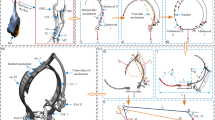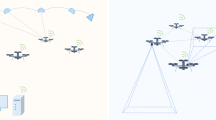Abstract
Small-size robots provide access and maneuverability in the tight confines of highly rubbled and uncertain environments such as those encountered in Urban Search and Rescue (USAR). Small size also provides easy portability and deployability and the potential for redundancy through multi-robot teaming. Unfortunately, small size does not diminish the data demands of these applications, such as high-resolution imagery and other forms of high bandwidth data. Furthermore, achieving redundancy in tight environments requires wireless operation to avoid the entanglement of tethers, but wireless communication links have proven unreliable in such environments. The net effect of this is a set of robust networking requirements that include high bandwidth, low latency, and low power with multi-hop routing in a sparse and highly volatile network configuration, which has been collectively difficult to achieve. Our metric for benchmarking these requirements is a stream of uncompressed 320 × 240, 24-bit color images updated at 1 frame per second (roughly 1.8 Mbps - image compression is not the focus of this research as it only serves to increase the possible resolution or frame rate). No existing ad hoc wireless sensor network approaches have been able to achieve these requirements. Wi-Fi requires high power and size and does not have the latency, while Zig-bee does not have the bandwidth. Instead, this work focuses on augmenting the Bluetooth protocol, which is master/slave based, with a hybrid, multi-hop routing protocol. Bluetooth has the desired low power and high bandwidth characteristics, but lacks multi-hop routing and rapid recovery. In this paper, a hybrid routing protocol for ad hoc multi-robot networking is described that features: (1) high-bandwidth, (2) low power, and (3) low latency of data traffic for sparse, highly volatile networks—exactly what is required for large teams of highly distributed, small-scale robots. Furthermore, this paper compares simulations and robot implementations of different routing protocols over Bluetooth sensor networks and demonstrates the viability of our protocol as a wireless network solution for multi-robot teams characterized by high mobility in difficult RF environments. To the best of our knowledge, the work presented in this paper is the first attempt at comparison of different routing protocols for real robots with physical experiments over Bluetooth sensor networks.
Similar content being viewed by others
References
Voyles R, Larson A, Bae J, Lapoint M (2004) Core-bored search-and-rescue applications for an agile limbed robot. In: Proceedings of the 2004 IEEE/RSJ international conference on intelligent robots and systems, vol 1, pp 58–66
Murphy R (2004) Human-robot interaction in rescue robotics. IEEE Syst Man Cybern 34(2): 138–153
Wolf A, Ben B, Casciola R, Costa A, Schwerin M, Shammas E, Choset H (2003) A mobile hyper redundant mechanism for search and rescue tasks. Las Vegas, Nevada, USA, pp 2889–2895
Casper J, Murphy R (2003) Human-robot interactions during the robot assisted urban search and rescue response at the world trade center. IEEE Syst Man Cybern 33(3): 367–385
Shah B, Choset H (2004) Survey on urban search and rescue robots. J Robot Soc Japan 22(5): 582–586
Voyles R, Bae J, Estrine E (2005) Human-activated displacement control appliance for use with computerized device/mechanism. US Patent 5,406,551
Voyles R, Larson A (2005) Terminatorbot: A novel robot with dual-use mechanism for locomotion and manipulation. IEEE/ASME Trans Mechatron 10(1): 17–25
Rypski P, Gini Stoeter MSA, Hougen D, Pananikolopoulos N (2002) Performance of a distributed robotic system using shared communications channels. IEEE Trans Rob Autom 18(5): 713–727
Rekleitis I, Dudek G (2005) Automated calibration of a camera sensor network. In: IEEE/RSJ international conference on intelligent robots and systems
Maxwell B, Ward N, Heckel F (2004) A configurable interface and software architecture for robot rescue. In: Sixteenth conference on innovative applications of artificial intelligence, San Jose, CA, USA, pp 25–29
Levis P, Culler D (2002) Mate: a tiny virtual machine for sensor networks. In: International conference on architectural support for programming languages and operating systems, San Jose, CA, USA (to appear)
Leopold M, Dydensborg M, Bonnet P (2003) Bluetooth and sensor networks: a reality check. In: SenSys, Los Angeles, California, USA
Jian Z, Fei Z, Bin W (2005) Cluster based routing in bluetooth ad-hoc network. In: Proceedings of wireless communications, networking and mobile computing, vol 2(12), pp 747–752
Barnhard DH, Wimpey BJ, Potter WD (2004) Odin and hodur: using bluetooth communication for coordinated robotic search. In: Proceeding of the international conference on artificial intelligence, Las Vegas, Nevada, USA
Royer EM, Toh CK (1999) A review of current routing protocols for ad hoc mobile wireless networks. IEEE Personal Communication, pp 46–55
Perkins CE, Bhagwat P (1994) Highly dynamic destination-sequenced distance-vector routing(dsdv) for mobile computers. In: Computer communications review, pp 234–244
Perkins CE, Royer EM (1999) Ad-hoc on-demand distance vector routing. In: Second IEEE workshop on mobile computer systems and applications, pp 99–109
Johnson D, Maltz D (1996) Dynamic source routing in ad hoc wireless networks. In: Mobile computing, pp 153–181
Park V, Corson M (1997) A highly adaptive distributed routing algorithm for mobile wireless networks. In: Proceedings of INFOCOM
Bae J, Voyles R (2006) Wireless video sensor network from a team of urban search and rescue robot. In: Proceedings of the international conference on wireless networks
Bluetooth specification version 1.2 in http://www.bluetooth.org, vol 1
Salonidis T, Bhagwat P, Tassiulas L, LaMaire R, (2001) Distributed topology construction of bluetooth personal area networks. In: IEEE INFOCOM, pp 1577–1586
Chiang CC, Wu H-K, Liu W, Gerla M (1997) Routing in clustered multihop mobile wireless networks with fading channel. In: Proceedings of IEEE SICON, pp 197–211
Bae J, Voyles R (2006) Wearable joystick for gloves-on human/computer interaction. In: Proceedings of the SPIE defense and security symposium, Orlando, FL, pp 229–238
Voyles R, Bae J (2008) The gestural joystick and the efficacy of the path tortuosity metric for human/robot interaction. In: Proceedings of the performance metrics for intelligent systems workshop, Gaitherburg, MD
Author information
Authors and Affiliations
Corresponding author
Rights and permissions
About this article
Cite this article
Voyles, R.M., Bae, J., Larson, A.C. et al. Wireless video sensor networks for sparse, resource-constrained, multi-robot teams. Intel Serv Robotics 2, 235–246 (2009). https://doi.org/10.1007/s11370-009-0053-8
Received:
Accepted:
Published:
Issue Date:
DOI: https://doi.org/10.1007/s11370-009-0053-8




